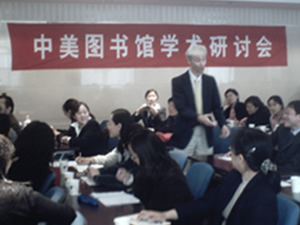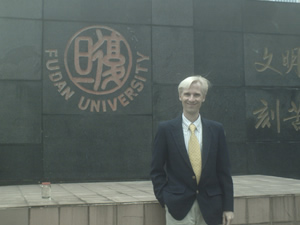|
|
Summer Travel
Journal: China
John Hickok
May, 2006
Greetings colleagues,
April is now concluded, and with it, my visit to China.
China is an enormous country, and even though I allotted more time
for it than any of my previous countries, it still was not enough.
There are hundreds of universities throughout China, ranging from internationally
prestigious (e.g., Peking University in Beijing) to extremely inadequate
(like some rural “universities” in
Central/Western China). Trying to see all of them was obviously impossible,
so I attempted to see a sampling instead.
Unfortunately, my sampling was too heavy on the eastern side of China.
Starting in the southeast, I followed the eastern coast of China northward:
Guangzhou, Xiamen, Shanghai, Nanjing and Beijing. This east coast route
is heavy with universities, thus the choice for traveling this direction.
However, these are also the most developed and highest-funded universities
in China — far different from
the poorer university conditions in Central and Western China. I
saw the outskirts of these less developed areas and interviewed librarians
and students who grew up there. It confirmed an increasingly evident
fact: a widening divide between resource-rich and resource-poor universities
in China (and reflective of the similar gap between rural poor and
urban rich).
Because of this gap, it is difficult to identify common trends/conditions.
The conditions are so vastly different between a million-dollar funded
university like Shanghai, and a struggling provincial “university” in the west — essentially,
a tiny rural community college. Thus, in looking for commonalties,
I had to acknowledge the economic extremes, then look for trends that
transcended the financial gap. Here are some of those observations.
Some strengths:
Eastern urban universities:
- Massive facility improvements/construction! Some of the newly
constructed libraries I visited were colossal structures — akin
to large performing arts centers you would find in major cities. Construction
cranes were everywhere. Likewise, heavy funding toward technology
was also everywhere — computer labs, library automation, wireless
networks, and so on.
- A strong commitment to cataloguing and automation. The majority
of China’s libraries use the home-grown Chinese classification
system (a character/letter code, like LC), and the cataloging operations
get high attention. Likewise, online catalogs exist at every location
(though not with common software; each library has developed its
own catalog software).
Western/rural universities:
- Although lacking modern facilities and technology, these universities
nevertheless shared a common strength: a strong commitment/tradition
to behind-the-scenes service (i.e., cataloging, classification, collection
management, etc.) Even in manual-only catalog situations, the attention
to detail was impressive.
Some challenges/weaknesses:
For both types of universities:
- A lack of — the tradition of — visible reference service.
Providing assistance for questions in the form of a separate reference
desk is not common in many China libraries. Far more common are “librarians” (explained
more, below) at the circulation desk or reading room desks — only
helping with basic “look-up” questions. For advanced
questions that may arise, librarians at these desks routinely send
students to a back office (too frequently unmarked) where more senior/trained
librarians are working (such as answering email/telephone/bbs reference
questions).
- A lack of differentiation between professionally degreed librarians
and support staff. All library staff are generically called “librarians,” whether
degreed/trained or just having worked there for many years. This
creates a problem. If less trained staff are answering reference
questions at the circulation desk — and not providing as high
of quality responses — then the stereotype that “all
librarians are merely just low-level clerks” persists.
- A lack of continual library training (user education). Nearly every
library I visited offered the typical “one-shot new student
library orientation” (PowerPoint lecture and tour), but beyond
that, continuing forms of training — such as workshops, sessions
for instructors’ classes, online tutorials — were not
so common. In several libraries, there was no proactive stance. That
is, librarians would help students if approached, but didn’t
have initiatives to reach out, unsolicited.
- An institutional distraction/drain on reference librarians. In
China, a badge of honor for a university is for the library to be
designated by the Ministry of Education as a “Novelty Research
Center.” That is, capable to start “checking” research/grants/proposals
from faculty — checking if the research has already been done,
chasing references, confirming patent/copyright clearances, etc.
While this honor may be praiseworthy, in reality, it drains incredible
time from reference librarians — often up to 60 percent of
their daily duties — time away from students, who should be
the priority clientele.
Opportunities
- Despite these challenges, China is at the crossroads for many exciting
opportunities. Librarians can ride the wave of technology to begin
more proactive outreaches. The old thinking of “just wait
for students to ask” can be replaced with new thinking of “let’s
offer and advertise library training sessions.”
- As more librarians enter libraries with degrees in library science
training, the opportunity exists to maximize these talented individuals.
Rather than assignments of merely monitoring a reading room, skilled
librarians can organize into creative teams for Web design, teaching
library sessions, producing subject brochures and more.
In all, China has the opportunity to develop some of the same dynamic
characteristics that many U.S. academic libraries enjoy (proactive
outreach, etc.). But it will need to make the commitment to move beyond
some longtime habits/traditions.
That is all for April. I send my warm wishes to all of you.
From Asia,
John
Giving a lecture to Beijing librarians, organized by the U.S. Embassy.
Rather than the traditional podium-and-PowerPoint approach, I made
it interactive and wandered among the audience — a new experience
for them!
An example of a massive library, newly built in China. This one
is at the Nanjing Finance & Economics University.
Visiting the library at Fudan University, where Cal State Fullerton
has its annual summer delegation.
Read more about John's Travels...
Japan and Korea
Mongolia
Taiwan |





 Produced by the Office of Public Affairs at California State University, Fullerton.
Contact the
Produced by the Office of Public Affairs at California State University, Fullerton.
Contact the